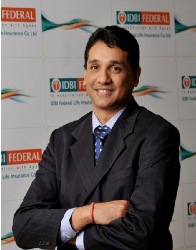New Delhi, Feb 20, 2015: The Union Budget 2015 would be presented against the backdrop of stable government, settled inflationary pressures and improved investment prospects. While the last year was the first budget announcement, current year’s budget would be carefully watched for key policy announcements and government’s approach towards a fiscal consolidation. Listed ahead are few of our observations and recommendations for the life insurance sector through this year’s budget exercise.
Direct Tax
Policy Term: The Government in the Finance Act, 2012 mentions that all insurance policies, except pension plans, need to offer a cover of at least 10 times the annual premium to be eligible for tax benefits undersection 80 C and section 10 (10D). Life Insurance industry had earlier recommended that the tax relief be linked to the term of the policy instead of sum assured. We expect that a tax relief is given to a proposal where the term of the policy is more than 10 years. This would promote long term savings habit and benefit the persistency ratio of life insurance companies as well. Further we suggest that the Section 10(10D) provision shall be suitably revised in line with the minimum assured death benefit guidelines prescribed by insurance regulator, IRDAI. This will iron out the disparity pertaining to the minimum death benefit condition and also would reduce the mis-selling complaints with respect to taxability of maturity proceeds.
Separate limit for long term savings products: Currently, investments in saving instruments including mutual fund, PPF, pension products, etc and other expenses including tuition fees, housing loan repayment etc are eligible for an aggregate deduction of Rs 1.5 Lakhs. While the increase in the cap was a step in the right direction, we further expect a separate limit for life insurance for long-term savings instruments like life insurance and pension products. The government should also look at special tax concessions for long term saving instruments separately and should not be clubbed with the existing tax limits. This will help promote a habit of systematic and consistent long term savings which is the need of the hour – both from an end consumer level as well as from an economic level.
Contribution to Superannuation fund: The limit of Rs.1 lakh should be removed, and the entire contribution towards superannuation should be tax free. The current applicable tax discourages employees from viewing a superannuation fund as an attractive investment avenue to meet their long term investment interests. Most employees/members of a superannuation scheme would like to consider an over Rs. 1 lakh contribution to a superannuation scheme as it would maximise their final annuity payouts and would fairly meet their retirement needs.
Pensions / Annuities: Currently, pension/annuity is taxable while in hands of the policy holders. To incentivize old age pension created by self-funding and considering that there are limited public social security benefits available and the fact that annuitants are generally senior citizens, we also expect a new section for exemption of pension under life insurance to be introduced through this budget. Similar to the tax treatment provided in case of NPS, a provision should be inserted or clarification should be issued that any amount received under pension/annuity plan which is used to buy an annuity plan will not be taxable in the year it is received.
Government may come up with some more procedural changes to ease administrative burden on life insurance Companies such as the ones mentioned below:
- Clarification on applicability of 194DA to certain insurance products should be provided by CBDT. Accordingly, it may be clarified that in case of payments under a pensions policy , annuity policy, health insurance policy or a superannuation policy, the provisions of section 194DA shall not be applicable. The threshold limit of Rs.1 lakh in a financial year should be increased and linked with basic exemption limit. Exemption from the applicability of Section 206AA to be provided viz., Form 60 should be considered equivalent to PAN for the purpose of deduction of TDS.
- Increase in threshold limit for deducting TDS on insurance Commission from current levels of Rs. 20,000/- to Rs. 50,000/-
- The issuance of TDS certificate under section 194C, 194D, 194I and 194J on a quarterly basis may be dispensed with. Alternatively, it may be allowed to issue on yearly basis as per Section 192. Further the TDS details are actively available on form 26AS of all the assesses in view of automations of the TDS system.
Indirect Tax
Service Tax on Policies: We do expect tax clarity and concessions from the budget. This includes service tax levied on various components on services/ various types of services offered including fund management charges, policy administration charges and mortality charges. We recommend revisiting service tax rate applicable on various insurance products. Especially on traditional and single premium products, which attract a high indirect tax making these products fairly expensive for the policyholders.
Rules relating to Point of Taxation (PoT) need to be simplified: The Point of Taxation (PoT) Rules requires insurance companies to pay tax in advance on the first premium as well any renewal premiums paid in advance. In case the policy gets cancelled, the insurance company is liable to refund the customers immediately; however it takes some time for the insurance companies to get a refund from the Government. This is quite inconvenient as companies end up losing interest on this amount. In order to simplify the tax administration, it is recommended that service tax liability should be made applicable: a) upon the ‘recognition of premium’ in case of new business b) ‘actual collection of cash’ in case of renewal premiums for traditional products c) ‘allocation of units’ in case of ULIP services.
Exemption from payment of service tax to services provided by life insurance agents:
Life Insurance Agents are also intermediaries, whose functions are similar to those of Mutual Fund Distributors. Therefore, the exemption provided to Mutual Fund Distributors in the Exemption Notification should be extended to Life Insurance Agents.
Eligibility of CENVAT Credit to Insurance Companies
With a view to avoid litigation, it is recommended that a suitable clarification or amendment in law be provided so as to clarify that the investment component and resultant income should not warrant any reversal of CENVAT Credit and Insurance companies are eligible for 100% CENVAT Credit.
Among other Expectations
The Government has already moved one more step towards facilitating increased FDI in the insurance sector. Insurance industry does need capital to stimulate growth. The scope for growth is enormous looking at the less than 4% penetration of insurance in the country. It needs to be seen if the ordinance goes through at the next level, however, this step amply demonstrates the will on the government’s end to revive industry growth. We look forward to the speedy execution of the policy.




























